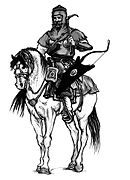| This article needs attention from an expert in Military history. Please add a reason or a talk parameter to this template to explain the issue with the article. WikiProject Military history may be able to help recruit an expert. (January 2024) |
You can help expand this article with text translated from the corresponding article in Polish. (01 2024) Click for important translation instructions.
|
| Towarzysz pancerny | |
|---|---|
 | |
| Allegiance | |
| Type | cavalry |
| Role | Standing professional military |
| Equipment | war hammer, Mace (bludgeon), hatchet, sabre spear Lance |
Armoured companion (Polish: Towarzysz pancerny Polish: [tɔˈvaʐɨʂ panˈtsɛrnɨ], plural: towarzysze pancerni) was a Polish medium-cavalryman in 16th to 18th century Polish-Lithuanian Commonwealth, named after their chainmail armor. These units were the second-most-important (and successful) cavalry in the Polish-Lithuanian army, after the hussars.
Most pancerni were recruited from the middle or lower classes of the Polish nobility.
These companions were organized into companies, with each company (Polish: chorągiew or rota) consisting of 60 to 200 horsemen.
The Cossacks were renamed armored cavalry (jazdę pancerną) in 1676 as the Cossack name was associated with the Khmelnytsky Uprising. After the reforms in 1776, both hussars and armored companions were transformed into National Cavalry units.
Arms and armour
They used chainmail or bechter armour to protect the upper body, vambrace sometimes with gauntlets, secretes (rarely lobster-tailed pot helmets), buckler shields, sabre, composite bow, pistols, and carbine. Earlier companies would sometimes be equipped with a horseman's pick, mace, or lance. During the rule of king John III Sobieski, lances became compulsory.
During the Middle Ages, under the rule of Mieszko I and Bolesław I the Brave, the name pancerni applied to the members of the duke's retinue. They were the wealthiest warriors in the Polish army, and as such, they could afford to wear sophisticated armour, most commonly chainmail. Their weapons included arming swords, axes, spears, shields, and strait bows.
Examples of Pancerny-
Armour and equipment of a Polish towarzysz pancerny, in the late 17th century at Muzeum Wojska Polskiego
-
 Chainmail, shield and weapons at Muzeum Wojska Polskiego
Chainmail, shield and weapons at Muzeum Wojska Polskiego
-
 Towarzysz pancerny by Dariusz T. Wielec
Towarzysz pancerny by Dariusz T. Wielec
-
 Pocztowy pancerny by Dariusz T. Wielec
Pocztowy pancerny by Dariusz T. Wielec
See also
- Polish cavalry
- Towarzysz
- Poczet
- Pocztowy
- Offices in the Polish-Lithuanian Commonwealth
- Petyhorcy
- Druzhina
References
- Sikora, Radosław (2005). Wojskowość polska w dobie wojny polsko-szwedzkiej 1626-1629. Kryzys mocarstwa. Poznań: Sorus.
- Sikorski, Janusz (1990). Polskie tradycje wojskowe: Tradycje walk obronnych z najazdami Niemców, Krzyżaków, Szwedów, Turków i Tatarów (in Polish). Wydawn. Min. Obrony Narodowej. pp. 191–199. ISBN 978-83-11-07675-4.
- Konstanty, Górski (1893). "Historya piechoty polskiej". Biblioteka Uniwersytecka W Poznaniu: 153.
Categories: